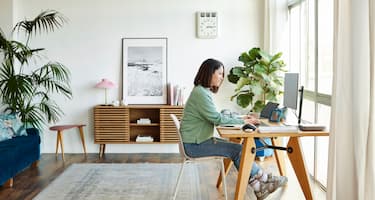Find out Australians' attitudes and beliefs about working from home from Budget Direct's latest survey.
Quick Stats
- 61% of Australians prefer a hybrid approach to work, blending working from home and in person.
- 36% of Australians mainly work from home to improve their work/life balance, while 15% work from home to avoid the commute.
- 45% of Australians would be more likely to turn down a job if an employer did not allow them to work from home.
Australian Work From Home Insights
In April 2020, up to 53% of Australians worked from home due to the COVID-19 pandemic. In the 5 years prior (from 2015-2020) around 30% of Australians had worked from home. [1]
By September 2020, 30% of Australians also worked from home most of the time. While this number fell to 24% by June 2021 [1], this was a significant increase from the 8% of Australians who worked from home most of the time in November 2008. [2]
In 2008, 34% of people worked from home to ‘catch up on work’, followed by 22% of people who ‘wanted an office at home with no additional expenses like overheads or rent’. [2]
By August 2021, 41% of employed people worked from home. The main reasons Australians worked from home were to ‘catch up on work’ and as ‘part of a flexible working arrangement’. [1]
While most workers presumably want to work from home, at least some of the time, the ability for people to do their job from home is strongly tied to their daily work tasks. In 2021, 64% of managers and professionals usually worked from home, compared to 25% for all other occupations. [1]
As a result, people who worked from home were more likely to: [1]
- Work more paid or unpaid overtime (compared to workers who did not work from home)
- Have an agreement (written or unwritten) to work flexible hours
- Work on weekdays only
Work From Home Survey Results
What is your employment status?*
*Respondents were able to choose ‘Other’ as a response. Results may not add up to 100%.
Nearly 70% (67.65%) of the Australians surveyed work full-time.
Of the female participants, 25% (24.37%) worked part-time compared to only 8% (8.14%) of male participants.
Only 60% (57.51%) of participants in Queensland worked full-time. And a quarter of participants from South Australia worked part-time.
What best describes your current working arrangements?^
^Due to how the figures are rounded within the survey data, numbers may not add up to exactly 100%.
Over 50% (52.55%) of the Australians surveyed sometimes work from home.
In post-pandemic Australia, there’s 0% of Australians surveyed who never work from home.
Nearly 30% (28.32%) of participants aged 58-67 mostly work from home.
Around 60% of participants from South Australia (60.87%) and Western Australia (58.57%) sometimes worked from home.
Which working arrangements do you prefer, working from home or in person?^
18-27 years |
28-37 years |
38-47 years |
48-57 years |
58-67 years |
|
|---|---|---|---|---|---|
Always working from home |
13.30% |
20.71% |
13.50% |
22.15% |
14.63% |
Always working in person (including coworking) |
12.23% |
3.03% |
5.52% |
6.04% |
7.32% |
Hybrid (a blend of working from home and in person) |
56.00% |
65.00% |
64.00% |
56.00% |
60.00% |
It depends on the day |
10.64% |
4.04% |
6.75% |
6.71% |
6.10% |
It depends on the circumstances |
6.38% |
7.07% |
9.82% |
7.38% |
12.20% |
Not sure |
1.06% |
0.00% |
0.00% |
1.34% |
0.00% |
NSW |
Vic |
Qld |
SA |
WA |
|
|---|---|---|---|---|---|
Always working from home |
18.50% |
20.19% |
15.89% |
5.48% |
12.73% |
Always working in person (including coworking) |
9.45% |
3.37% |
5.96% |
12.33% |
5.45% |
Hybrid (a blend of working from home and in person) |
59.00% |
61.00% |
58.00% |
64.00% |
71.00% |
It depends on the day |
6.30% |
6.73% |
9.27% |
8.22% |
3.64% |
It depends on the circumstances |
7.09% |
8.17% |
9.93% |
8.22% |
7.27% |
Not sure |
0.00% |
0.48% |
1.32% |
1.37% |
0.00% |
^Due to how the figures are rounded within the survey data, numbers may not add up to exactly 100%.
Of the Australians surveyed, 61% prefer a hybrid approach to work, blending working from home and in person. And nearly 20% (17.05%) of Australians prefer to always work from home.
Nearly 10% (9.48%) of female participants said that their preferences depend on their circumstances.
Of respondents aged 28-37, 65% prefer a hybrid approach to working.
Of the South Australians surveyed, 12% prefer to always work in person.
Do you work longer hours when working from home or in person?^
^Due to how the figures are rounded within the survey data, numbers may not add up to exactly 100%.
Over 30% (31.28%) of Australians surveyed work longer hours when working from home.
Of the female respondents, 17% answered that their preference depends on the day.
Nearly 40% (38.65%) of participants aged 38-47 worked longer hours at home compared to 30% (31.38%) of participants aged 18-27 who worked longer hours in person.
Of the Victorians surveyed, 37% worked longer hours when they were at home.
When did you start working from home?^
^Due to how the figures are rounded within the survey data, numbers may not add up to exactly 100%.
Of the Australians surveyed, 33% started working from home 3 years ago in 2020 at the start of the COVID-19 pandemic.
Of the respondents aged 28-37, 43% started working from home 3 years ago. And nearly 40% (37.27%) of 18-27 year olds started working from home 2 years ago.
Of the Victorians surveyed, 40% started working from home 3 years ago.
What is the main reason you work from home?^
^Due to how the figures are rounded within the survey data, numbers may not add up to exactly 100%.
Of the Australians surveyed, 36% mainly work from home to improve their work/life balance, while 15% work from home to avoid the commute.
Out of the female respondents, 38% mainly work from home for work/life balance.
More than 10% of 28-37 year olds mainly work from home to improve their health and/or mental health.
Out of the South Australians surveyed 42% worked from home to improve their work/life balance while 18% of Victorians want to avoid the commute.
What is the main reason you work in person?^
NSW |
Vic |
Qld |
SA |
WA |
|
|---|---|---|---|---|---|
Increase productivity |
9.06% |
9.13% |
9.27% |
6.85% |
3.64% |
Improve health and/or mental health |
5.51% |
4.33% |
3.97% |
5.48% |
7.27% |
Work/life balance |
11.00% |
12.00% |
13.00% |
11.00% |
13.00% |
Condition of employment |
20.00% |
25.00% |
23.00% |
33.00% |
16.00% |
Social interaction |
22.00% |
25.00% |
15.00% |
14.00% |
24.00% |
To catch up on work |
5.00% |
3.00% |
5.00% |
3.00% |
2.00% |
Better communication |
15.00% |
15.00% |
22.00% |
14.00% |
15.00% |
To avoid distractions |
7.00% |
5.00% |
3.00% |
5.00% |
11.00% |
Not sure |
2.00% |
1.00% |
3.00% |
0.00% |
5.00% |
Other |
4.00% |
2.00% |
3.00% |
8.00% |
4.00% |
^Due to how the figures are rounded within the survey data, numbers may not add up to exactly 100%.
Of the Australians surveyed, 23% work at an in person location as a condition of employment.
Out of the female respondents, 25% mainly work in person for social interaction, while nearly 30% of 28-37-year-olds prefer to work in person for the same reason.
Of the 58-67 year olds surveyed, 21% work in person for better communication with other teams.
In your opinion, what is the main downside of working from home?^
Female |
Male |
|
|---|---|---|
Distractions |
13.06% |
21.20% |
Poor work/life balance |
2.53% |
5.14% |
Lack of social interaction |
41.00% |
32.00% |
Poor communication |
4.00% |
7.00% |
Poor productivity |
5.00% |
7.00% |
Poor health and/or mental health |
2.00% |
3.00% |
Difficult home life |
2.00% |
4.00% |
None |
25.00% |
19.00% |
Not sure |
3.00% |
2.00% |
Other |
1.00% |
2.00% |
^Due to how the figures are rounded within the survey data, numbers may not add up to exactly 100%.
Of the Australians surveyed, 37% think that the lack of social interaction is the main downside of working from home.
Of 28-37 year olds surveyed, 42% also think the main downside of working from home is the lack of social interaction. And 33% of participants aged 58-67 think that there are no downsides to working from home.
In your opinion, what is the main downside of working in person?^
18-27 years |
28-37 years |
38-47 years |
48-57 years |
58-67 years |
|
|---|---|---|---|---|---|
Distractions |
10.64% |
14.65% |
12.88% |
13.42% |
19.51% |
Commuting to work |
34.04% |
47.47% |
42.33% |
43.62% |
34.15% |
Poor work/life balance |
15.00% |
14.00% |
13.00% |
9.00% |
7.00% |
Poor work environment |
3.00% |
4.00% |
7.00% |
2.00% |
2.00% |
Poor communication |
4.00% |
1.00% |
2.00% |
3.00% |
0.00% |
Poor productivity |
6.00% |
5.00% |
7.00% |
3.00% |
1.00% |
Poor health and/or mental health |
6.00% |
3.00% |
4.00% |
3.00% |
4.00% |
Being away from home |
11.00% |
8.00% |
6.00% |
9.00% |
6.00% |
None |
6.00% |
2.00% |
4.00% |
10.00% |
22.00% |
Not sure |
3.00% |
2.00% |
2.00% |
3.00% |
1.00% |
Other |
2.00% |
1.00% |
0.00% |
1.00% |
2.00% |
NSW |
Vic |
Qld |
SA |
WA |
|
|---|---|---|---|---|---|
Distractions |
12.60% |
11.06% |
19.87% |
12.33% |
16.36% |
Commuting to work |
40.94% |
45.19% |
35.76% |
42.47% |
36.36% |
Poor work/life balance |
14.00% |
11.00% |
9.00% |
14.00% |
9.00% |
Poor work environment |
4.00% |
3.00% |
4.00% |
3.00% |
5.00% |
Poor communication |
2.00% |
2.00% |
3.00% |
0.00% |
4.00% |
Poor productivity |
5.00% |
6.00% |
4.00% |
3.00% |
2.00% |
Poor health and/or mental health |
3.00% |
5.00% |
7.00% |
1.00% |
4.00% |
Being away from home |
8.00% |
8.00% |
5.00% |
15.00% |
4.00% |
None |
7.00% |
5.00% |
8.00% |
5.00% |
15.00% |
Not sure |
2.00% |
3.00% |
2.00% |
3.00% |
5.00% |
Other |
1.00% |
1.00% |
2.00% |
1.00% |
0.00% |
^Due to how the figures are rounded within the survey data, numbers may not add up to exactly 100%.
Of the Australians surveyed, 41% think that commuting to work is the main downside of working in person.
Of the female respondents, 13% think that a poor work/life balance is the main downside.
Of 18-27 year olds surveyed, 11% think being away from home is the main downside. And 22% of 58-67 year olds think there isn’t a downside to working in person.
Do you have a dedicated home office?^
^Due to how the figures are rounded within the survey data, numbers may not add up to exactly 100%.
Nearly 70% (67.96%) of Australians surveyed have a dedicated home office.
More than 76% of respondents in Queensland and 74% in Western Australia have a dedicated home office.
When you work from home, what best describes the workstation you use most often?^
^Due to how the figures are rounded within the survey data, numbers may not add up to exactly 100%.
Over 60% (61.08%) of Australians surveyed use a desk most often when they work from home while 23% of Australians use a standard table.
Of participants aged 18-27, 10% use a stand-up desk most of the time they work from home.
If an employer did NOT allow you to work from home, would that affect your decision to take a job?^
^Due to how the figures are rounded within the survey data, numbers may not add up to exactly 100%.
Of the Australians surveyed, 45% would be more likely to turn down a job if an employer did not allow them to work from home.
Nearly 50% (48.93%) of female participants would be more likely to turn down a job.
Of 28-37 year olds surveyed, 55% (54.81%) would be more likely to turn down a job if they weren’t allowed to work from home.
Over 50% (52.14%) of Victorian respondents would be more likely to turn down a job.
Key Takeaways
Lack of social interaction is the largest downside of working from home
Almost a third of Australians surveyed believe the lack of social interaction is the main downside of working from home. In the wake of the COVID-19 pandemic, social isolation and loneliness have been major concerns worldwide. Loneliness and social isolation can negatively impact Australians' mental and physical health. [3]
The lack of social interaction was the main downside for participants aged 28-37, more than other age groups. Of participants in this age group, 30% also mainly work in person for social interaction, supporting this sentiment.
Commuting to work is the biggest downside of working in person
More than 40% of Australians surveyed think commuting to work is the main downside of working in person. The average commute time has increased to 48 minutes each day and an average of 4.5 hours per week going to and from work. [4]
Of the Australians surveyed, 15% also work from home to avoid the commute.
Flexible working arrangements will be expected from employers moving forward
A third of Australians surveyed work from home to improve their work/life balance. Flexible working arrangements are now commonplace amongst many Australian workplaces and have proven to be a more enjoyable way for Australians to combine work and family support care responsibilities.
Out of all respondents, 45% would also be more likely to turn down a job if an employer did not allow them to work from home. The current attitude towards flexible working reflects an ongoing trend in the Australian workplace.







